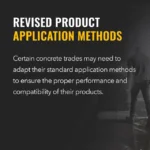Type 1L Concrete: What it is, Understanding the Shift, and Optimizing Your Projects
Type 1L cement substitutes raw limestone for a corresponding amount of Portland cement. However, these compositional changes present both opportunities and challenges. Understanding how Type 1L might affect setting times, workability, and surface characteristics is crucial for maintaining quality results, protecting your reputation, and ensuring optimal performance across various applications. This page provides a comprehensive guide to Type 1L, exploring potential benefits, practical considerations, and industry-specific best practices to help you navigate this shift successfully.
How Type 1L Impacts You and Your Business
Applicators are on the front lines of Type 1L adoption. Proactive engagement is key for success. Implement these strategies to stay ahead of the curve:
- Engage Early: From pre-bid to pre-construction meetings, ask questions and seek clarity to align expectations and address issues.
- Understand Your Concrete: Know the slab’s composition. Review mix designs, conduct scratch tests, and ensure appropriate hardness before starting.
- Prepare for Thirsty Concrete: Type 1L may require more densifier due to its porosity. Consider this possible added expense in your bids.
- Document Everything: Record any discoloration or uneven finishing before beginning your work. Use photos and formal documentation for approvals and communicate potential issues upfront.
Architects can help lay the foundation for Type 1L success by making informed decisions early in the design process. Focus on these strategies:
- Transparent Mix Design: Prioritize clear documentation for mix design to enhance collaboration and informed decision-making across all stakeholders.
- Foster Collaboration & Communication: Combine efforts in working closely with project teams and maintaining open dialogues to address challenges and craft effective solutions together.
- Embrace Learning: Commit to continuous research and testing of Type 1L concrete to stay ahead of industry standards and innovations.
- Set Clear Expectations: Ensure all parties are aligned by transparently communicating project specifics, including costs, testing, mock-ups, and any adjustments needed.
For general contractors, mastering projects with Type 1L concrete hinges on thorough preparation and strategic partnerships. Consider these essential strategies:
- Thorough Planning & Collaboration: Start with detailed planning, understanding Type 1L concrete’s requirements and potential challenges, and collaborate closely with experienced suppliers for tailored advice.
- Quality Control & Mix Design: Emphasize strict quality control and careful mix design to achieve desired outcomes while managing temperature and incorporating supplementary materials as needed for optimal performance.
- Education & Communication: Ensure all personnel are well-trained on Type 1L concrete’s properties and maintain open communication with all stakeholders to proactively address challenges and adapt schedules effectively.
Concerns
Getting ahead with Type 1L concrete means knowing what to expect. These images show you the common issues, so you can plan better and be the expert everyone wants on their project.
SLOW STRENGTH GAIN / SOFTNESS
- Concrete hardness determined by Mohs pencil hardness test; grinding recommended only when hardness is 5+.
- Ramifications: Extended timelines, increased costs, susceptibility to heavy equipment damage, surface imperfections.
HIGHER WATER DEMAND, SLOW BLEED WATER, DIFFICULTY FINISHING
- Higher water demand and slow bleed water migration in Type 1L concrete lead to finishing issues and a porous surface.
- Ramifications: Increased porosity, surface defects (blisters, crusting, scaling), reduced slab density, decreased surface strength.
INCREASED AMOUNT OF CRACKING
- Higher water demand for Type 1L concrete placement causes excessive plastic and dry shrinkage cracks.
- Ramifications: Aesthetic issues, moisture infiltration, surface durability problems, potential structural integrity issues, increased mitigation/maintenance costs.
SURFACE PINHOLES
- Prolonged bleed water migration traps air bubbles, forming pinholes exposed by polishing.
- Ramifications: Aesthetic issues, inhibits polished sheen, increased costs for pinhole filling and surface smoothing.
TOP SURFACE CRUSTING
- Early-stage curing issue where the surface dries faster than underlying layers, leading to a weaker, porous crust.
- Ramifications: Reduced durability, increased moisture and contaminant permeability, aesthetic concerns.
DISCOLORATION AND BLOTCHINESS
- Caused by prolonged bleed water presence and reduced calcium content, leading to uneven hydration.
- Ramifications: Aesthetic concerns, inconsistent appearance, perception of poor quality, difficult to remedy, potential indicator of long-term performance issues.
Considerations
Getting the best out of Type 1L concrete means focusing on the on the basics: good documentation, adjusting how you work, using test slabs, and watching your budget and timeline. Understanding these key considerations will empower you to make informed decisions and adapt your practices for a seamless transition to Type 1L.
TRANSPARENT MIX DESIGN DOCUMENTATION
- Enhances collaboration and ensures accountability among project stakeholders.
- Provides a framework for effective anticipation and planning of concrete-related tasks.
- Fosters teamwork and alignment for optimal outcomes and exceeding expectations.
REVISED PRODUCT APPLICATION METHODS
- Adapts application methods for Type 1L concrete to ensure product performance and compatibility.
- May require a double application of chemical densifier for strength and proper densification.
- Ensures the concrete floor’s hardness for effective grinding and polishing.
IMPORTANCE OF TEST SLABS & MOCKUPS
- Critical for verifying full-scale application performance on Type 1L concrete projects.
- Helps identify and address potential challenges upfront, ensuring expectations are met.
EXTENDED TIME FRAMES & ADDED COSTS
- Anticipate possible extended time frames and additional costs due to adapted application practices.
- Adjustments may impact project schedules and budgets, requiring careful planning and management.
- Emphasizes the need for realistic expectations and effective project delivery strategies.
FAQs
Yes. Ashford Formula and RetroPlate are effective and work well on Type 1L concrete surfaces. This has been confirmed in a series of tests, including 3rd party long-term testing of cores sent for petrography.
NOTE: Applicators should thoroughly assess and comprehend the characteristics of the floor, as adjustments to application techniques may be necessary to attain comparable densification benefits to those typically observed with OPC.
In simple terms, producing Type 1L cement results in a smaller carbon footprint compared to Ordinary Portland Cement (OPC). This is because it involves less cement calcination (heating limestone in a kiln triggering a chemical reaction converting it into clinker) and uses less fossil fuel, thereby reducing CO2 emissions.
Type 1L concrete matches the strength of standard OPC concrete. Yet, numerous unknowns persist, demanding further research and testing to grasp its full potential—including strength, finishing, appearance, and long-term performance. These variables may diverge from typical OPC expectations, warranting increased attention, research, testing, and adaptation.
Type 1L concrete may affect construction project schedules due to the need for additional time in research, testing, and adapting construction processes. This necessity stems from numerous unknown factors associated with Type 1L concrete, demanding further investigation to comprehensively grasp their impact on construction timelines.
Watch & Learn
Video: Type 1L Cement: Challenges & Opportunities You Need to Know – We delve into the benefits, potential risks, and how Curecrete is finding innovative solutions to optimize your outcomes.
Type 1L Cement: Challenges & Opportunities You Need to Know
Course Summary: This course delves into Type 1L concrete’s role in exposed concrete flooring, addressing its properties, challenges, best practices and impacts on professional trades and project stakeholders.
Course Code: CDIT1L
Course Credits: 1LU | HSW









